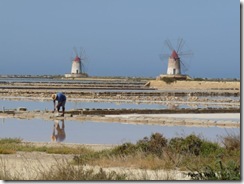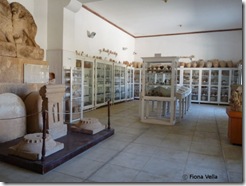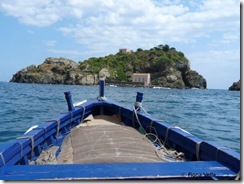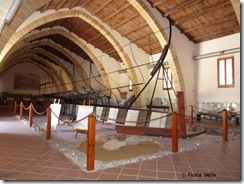-
Separating history and myths in Italian islands
The Cyclops Archipelago in Aci Castello
The municipality of Aci Castello which is situated in the eastern side of Sicily, in the province of Catania, can guarantee a journey which could be enriched with a touch of legend, a zest of traditional religious rituals and a taste of history and archaeology.
The town itself has been developed around a Norman castle that was constructed in black lava stone in 1076 upon the foundations of an earlier 7th century Byzantine fortification. A walk through Aci Castello’s historical centre will reveal a refined baroque style architecture, whilst a stroll along its splendid crystal blue beaches will expose the area’s natural beauty.
Yet the highlight attraction of this region is the Cyclops archipelago with its odd concentration of huge volcanic rocks which have manouvered their way out from the visceral depths of the earth and projected themselves high up into the realm of Aci Trezza bay. Their mysterious allure is believed to have inspired Homer whilst he was writing his epic ‘The Odyssey’ and from then on these features became legend when he alluded that this archipelago was created when the blinded Cyclops Polyphemus threw enormous rocks at the retreating Ulysses.
Visitors can enjoy a boat ride around these spectacular rock pillars known as ‘faraglioni’ whilst it is also possible to land on Faraglione Grande which is basically an enormous basalt rock which has been turned into a religious sanctuary by the locals. A stone staircase will lead sightseers up to a statue of Our Lady holding baby Jesus which overlooks the town of Aci Castello. In early September, this particular faraglione is delightfully adorned with numerous candles which are lit at night during the feast dedicated to Our Lady. Devotees who visit this site leave rosary beads hanging on the statues’ hands, and flowers at its feet as a supplication and thanksgiving for the protection of the town. Indeed, one might be interested to know that the town of Aci Castello had to be reconstructed twice after the zone was completely destroyed by earthquakes which took place in 1170 and in 1693.
During this boat trip, one could also opt to stop over at the little island of Lachea which lies only a few metres away from the faraglioni. Here, one can visit a museum which exhibits collections of flora, fauna and archaeological artifacts which have been retrieved from this island.
In order to preserve this valued environment, in 1989, the Cyclops archipelago together with Lachea island were established as a protected marine reserve.
Motya and the natural reserve of Stagnone in Marsala
Another exceptional route is located in Marsala which is situated off the west coast of Sicily, in the province of Trapani. Here one can travel back in time and experience the history of the ancient island of Motya and that of its devoted escort – the lagoon of Stagnone.
Back in the 8th century BC, it was the Phoenician colonizers who named the island as Motya. At the time, this small stretch of land with an area of 400,000 square metres was unattractive and inhospitable, and yet these intrepid colonizers succeeded to turn it into one of the most powerful cities of that period, particularly by using its natural resources.
In fact, the Phoenicians set up to build numerous basins in which to collect salt, and started to export this valuable commodity all over the Mediterranean. Moreover, apart from obtaining a good supply of fish from the Stagnone lagoon, they exploited its fertile under-water habitat by coming up with an ingenious way of extracting a purple dye from murex shells with which they coloured textiles and demanded good money for them.
Due to its strategic position along the trade route, Motya often found itself involved in the power struggles among the various empires which wanted to possess Sicily and therefore, high defensive walls were constructed around the island in order to offer it better protection. However this small domain ended in the 4th century BC when Motya was attacked and completely destroyed by warriors who came from Syracuse.
Later on, in the medieval period, this island offered refuge to a number of friars who renamed it San Pantaleo, and it was only in the end of the 19th century, when the name Motya appeared again. This took place when a British tradesman, Joseph Whitaker, whose family was renowned for the production of Marsala wines, took ownership of this island and he came upon some archaeological remains of the ancient city. Whitaker took the responsibility to finance extensive archaeological excavations on this island and he even built a museum on it in order to exhibit some of the artifacts that were unearthed.
Nowadays, Motya is the property of the NGO Whitaker Foundation and it is open for public viewing. The old-fashioned Whitaker museum is a gem for history enthusiasts and it is definitely worth a visit before seeing the rest of the island. Meanwhile, if one decides to walk around the island, it is advisable to apply an insect repellent since many insects are attracted to this area due to the still waters of the nearby lagoon. A walk along Motya’s archaeological remains will manifest significant structures which pertain to different eras, including a tophet which is located at the far end of this island. This sacred ground overlooking the sea is believed to be a cemetery wherein the remains of small sacrificed children used to be buried in small urns after they were offered by the Phoenicians to their god, Baal Hammon.
Since 1984, the Stagnone lagoon has been designated as a nature reserve of special interest and it has become one of the prominent itineraries of this zone. A salt museum which has been set up in a 300-year old saltworkers’ house explains the old practice of collecting salt and exhibits an array of various specialist tools. Moreover, visitors will definitely be enchanted by the presence of numerous old windmills which are scattered among the vast expanse of salt pans that are still in use.
During the day, regular boat trips take visitors across the shallow waters of the Stagnone lagoon and over to the island of Motya. However, one may prefer to enjoy a romantic tour during sunset when the lagoon area absorbs the lovely colours of the sky and all the salt pans turn to a gorgeous pink hue.
Archaeological Museum of Baglio Anselmi in Marsala
It is believed that the nearby city of Lilybaeum (modern Marsala) was originally set up by some of the inhabitants of Motya who had managed to escape during its downfall.
Lilybaeum acted as a naval military stronghold of the Carthaginians but in the 3rd cetury, when it became a Roman colony, its economy prospered even more. Nonetheless these areas seemed to be destined to a short existence, and in the 5th century this city was attacked and crushed by the Vandals.
One can trail the fascinating past of this region by visiting the archaeological museum of Baglio Anselmi in Marsala. The site provides a rich collection of archaeological remains which have been recovered both from the area of ancient Lilybaeum and also from the island of Motya.
Undoubtedly, the main attraction of this museum is the wreck of a Punic warship which was reclaimed from the sea after it was discovered in 1969 in an area called Punta Scario in the harbour of Marsala, near the Aegadian Islands.
(This article was published in the Travel Section of The Times of Malta on Sunday dated 25th May 2014)
Category: Torca - Perspettivi | Tags:



